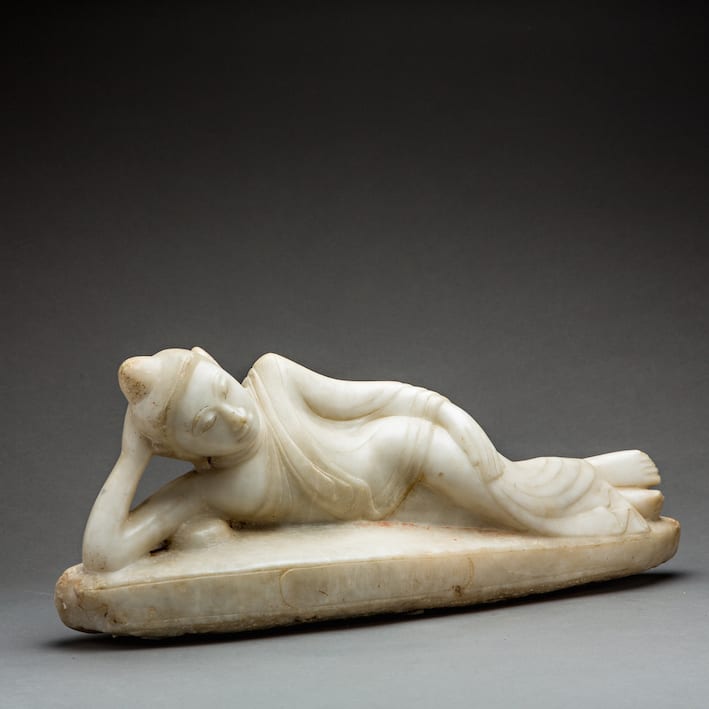Mandalay Marble Parinirvana Buddha, 19th Century CE
Marble
20.3 x 48.9 cm
8 x 19 1/4 in
8 x 19 1/4 in
LO.1006
Further images
The Mandalay Period represents the last great cultural flourishing of Burmese art. The period was named after the city of Mandalay, which served as capital of Myanmar for a brief...
The Mandalay Period represents the last great cultural flourishing of Burmese art. The period was named after the city of Mandalay, which served as capital of Myanmar for a brief period (1860-1885 A.D.) during the reign of King Mindon. After the Anglo-Burmese Wars, northern Myanmar was shut off from the coastal areas that were controlled by the British. King Mindon founded the new capital at a sacred site at the foot of a large hill. The center of the city was designed in the perfect geometrical form of a Buddhist Mandala, giving the city its name. Although this short-lived kingdom finally fell to the British forces in 1886 A.D. during the Third Anglo-Burmese War, the Royal Guilds that created such remarkable works of art for the King remained in the city where they continued to produce sculptures in the Mandalay style.
Delicate marble sculpture of the reclining Buddha, one arm resting on his side, the other supporting the head slightly bent on one side, his face with a serene smile and the eyes half cast in meditation, his sanghati softly draped. On the plinth a small inscription.
In Buddhism, the parinirvana is the final nirvana, traditionally understood to be within reach only upon the death of someone who attained complete enlightenment. It is the ultimate goal of Buddhist practice and implies a release from the cycle of deaths and rebirths as well as the dissolution of all mental aggregates (form, feeling, perception, mental fabrications and consciousness).The historical Buddha is believed to have died and reached parinirvana (or Maha Parinirvana) around 544 BC in the site of Kusinagar in India. Such event has been depicted copiously throughout East Asia and had a profound effect on the Hinayana Buddhist iconography of Thailand and Burma, where very large versions of the reclining Buddha are indeed to be found.
This image of the reclining Buddha emanates a sense of cultivation and grace. Its polished appearance and serenely reposed body bespeaks of the Buddha's exalted and transcendental existence. Propping the head with one hand, the Buddha rests its smoothened hair and usnisa facing forward with a tranquil expression, at the point of his final departure from his earthly existence. The features are well-defined--arched eyebrows, narrow eyes, long nose, delicate mouth and elongated earlobes. This reclining Buddha takes on a beautiful form, with soft curves and twists in the body arranged to convey the spiritual opulence and transcendental detachment of Buddhahood.
Delicate marble sculpture of the reclining Buddha, one arm resting on his side, the other supporting the head slightly bent on one side, his face with a serene smile and the eyes half cast in meditation, his sanghati softly draped. On the plinth a small inscription.
In Buddhism, the parinirvana is the final nirvana, traditionally understood to be within reach only upon the death of someone who attained complete enlightenment. It is the ultimate goal of Buddhist practice and implies a release from the cycle of deaths and rebirths as well as the dissolution of all mental aggregates (form, feeling, perception, mental fabrications and consciousness).The historical Buddha is believed to have died and reached parinirvana (or Maha Parinirvana) around 544 BC in the site of Kusinagar in India. Such event has been depicted copiously throughout East Asia and had a profound effect on the Hinayana Buddhist iconography of Thailand and Burma, where very large versions of the reclining Buddha are indeed to be found.
This image of the reclining Buddha emanates a sense of cultivation and grace. Its polished appearance and serenely reposed body bespeaks of the Buddha's exalted and transcendental existence. Propping the head with one hand, the Buddha rests its smoothened hair and usnisa facing forward with a tranquil expression, at the point of his final departure from his earthly existence. The features are well-defined--arched eyebrows, narrow eyes, long nose, delicate mouth and elongated earlobes. This reclining Buddha takes on a beautiful form, with soft curves and twists in the body arranged to convey the spiritual opulence and transcendental detachment of Buddhahood.





